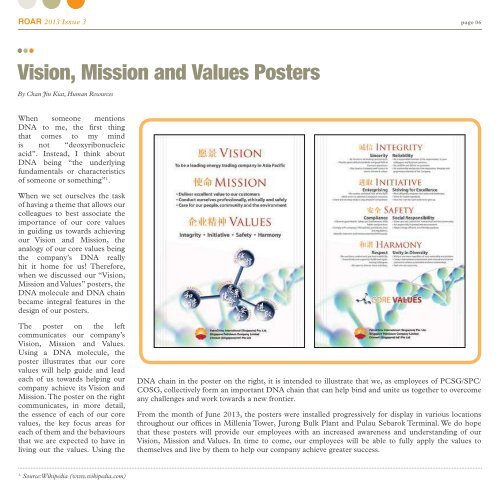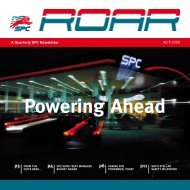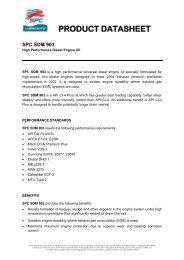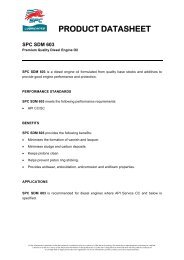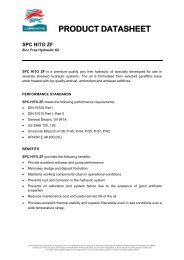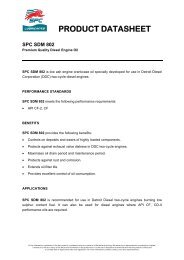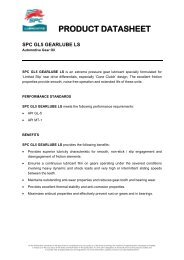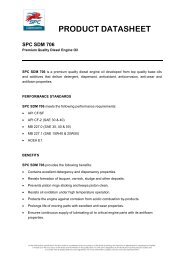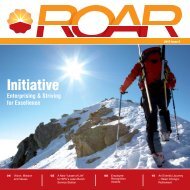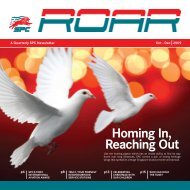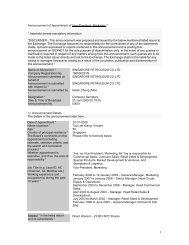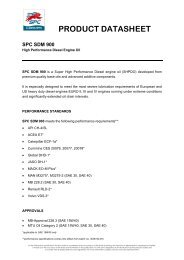Roar - SPC
Roar - SPC
Roar - SPC
Create successful ePaper yourself
Turn your PDF publications into a flip-book with our unique Google optimized e-Paper software.
ROAR 2013 Issue 3 page 06<br />
ROAR 2013 Issue 3 page 07<br />
Vision, Mission and Values Posters<br />
By Chan Jin Kiat, Human Resources<br />
When someone mentions<br />
DNA to me, the first thing<br />
that comes to my mind<br />
is not “deoxyribonucleic<br />
acid”. Instead, I think about<br />
DNA being “the underlying<br />
fundamentals or characteristics<br />
of someone or something” 1 .<br />
When we set ourselves the task<br />
of having a theme that allows our<br />
colleagues to best associate the<br />
importance of our core values<br />
in guiding us towards achieving<br />
our Vision and Mission, the<br />
analogy of our core values being<br />
the company’s DNA really<br />
hit it home for us! Therefore,<br />
when we discussed our “Vision,<br />
Mission and Values” posters, the<br />
DNA molecule and DNA chain<br />
became integral features in the<br />
design of our posters.<br />
The poster on the left<br />
communicates our company’s<br />
Vision, Mission and Values.<br />
Using a DNA molecule, the<br />
poster illustrates that our core<br />
values will help guide and lead<br />
each of us towards helping our<br />
company achieve its Vision and<br />
Mission. The poster on the right<br />
communicates, in more detail,<br />
the essence of each of our core<br />
values, the key focus areas for<br />
each of them and the behaviours<br />
that we are expected to have in<br />
living out the values. Using the<br />
DNA chain in the poster on the right, it is intended to illustrate that we, as employees of PCSG/<strong>SPC</strong>/<br />
COSG, collectively form an important DNA chain that can help bind and unite us together to overcome<br />
any challenges and work towards a new frontier.<br />
From the month of June 2013, the posters were installed progressively for display in various locations<br />
throughout our offices in Millenia Tower, Jurong Bulk Plant and Pulau Sebarok Terminal. We do hope<br />
that these posters will provide our employees with an increased awareness and understanding of our<br />
Vision, Mission and Values. In time to come, our employees will be able to fully apply the values to<br />
themselves and live by them to help our company achieve greater success.<br />
Corporate Value Introduction Series:<br />
SAFETY<br />
By Benjamin Ong, Refinery Projects & Commerical, Refining<br />
This is the first article to an introductory series on our corporate<br />
values. We begin by highlighting safety and the importance of<br />
consistent compliance to safe and environmental practices and<br />
being socially responsible towards both the community where<br />
we conduct our businesses and the environment. These help to<br />
create a safe working environment and maintain the company’s<br />
aim as a responsible oil and gas operator in the region.<br />
As employees, we play a significant role in contributing to<br />
our company’s Health, Safety and Environmental (HSE)<br />
performance through six practices, namely:<br />
1. Observance of good HSE habits and practices;<br />
2. Complying with PCSG’s HSE policies, procedures,<br />
laws and regulations;<br />
3. Continuous identification, intervention and elimination<br />
of potential HSE hazards;<br />
4. Including care and concern for human lives and the<br />
community as part of business decision making;<br />
5. Acting responsibly to protect the environment; and<br />
6. Adopting energy-efficient, eco-friendly practices.<br />
How these six practices function can be illustrated with the<br />
Reason’s Swiss Cheese Model in the figure. Each cheese slice<br />
represents a protective layer of check-and-control measure<br />
that prevents an incident from occurring. These measures can<br />
include activities like pre-work risk assessments, procedural<br />
controls and audit, which unfortunately may have inherent<br />
limitations and gaps, represented by the “holes” in the cheese.<br />
Incidents could be an explosion, injury at work or reputational<br />
loss/embarrassment for the company due to an oil spillage and<br />
damage to the environment. They occur when all the holes from all the<br />
protective layers coincide and a hazard or risk passes through the layer<br />
undetected, subsequently developing into a full-scale incident.<br />
When each employee applies the six practices diligently to the<br />
existing protective layers, the “holes in the cheese” are controlled<br />
and reduced layer by layer. Conversely, when these six practices are<br />
neglected, the number of incidents will generally increase. With a<br />
practice of continuous identification of HSE hazards, employees will<br />
begin to take more precautions and identify better ways to<br />
strengthen existing controls, thereby identifying gaps and<br />
closing the “holes” in the cheese, increasing the chances of<br />
hazard or risk detection and improving the general HSE level<br />
of the workplace.<br />
Hazards<br />
& Risks<br />
Pre-existing<br />
Factors<br />
Organisational<br />
Factors<br />
Unsafe<br />
Supervision<br />
Unsafe<br />
Acts<br />
Figure: Reason’s Swiss Cheese Model<br />
Incidents<br />
So as you are reading this, where are some areas in which you can<br />
apply these six practices to make our safety system more robust and the<br />
“holes” smaller?<br />
1.<br />
Source: Wikipedia (www.wikipedia.com)


